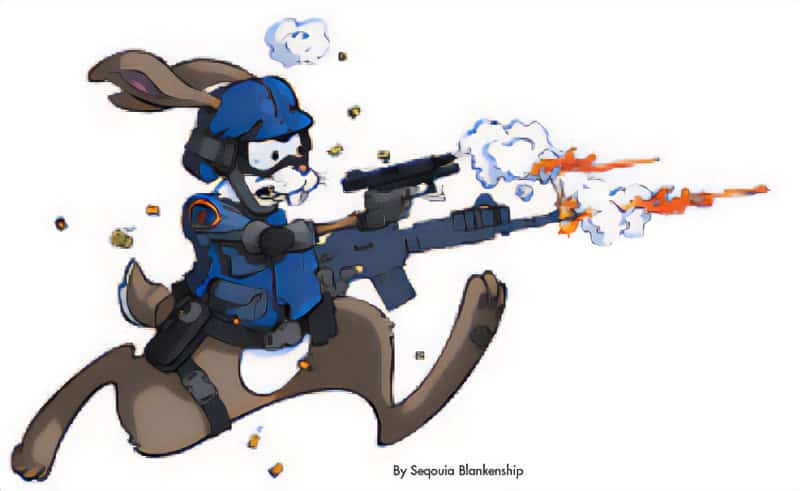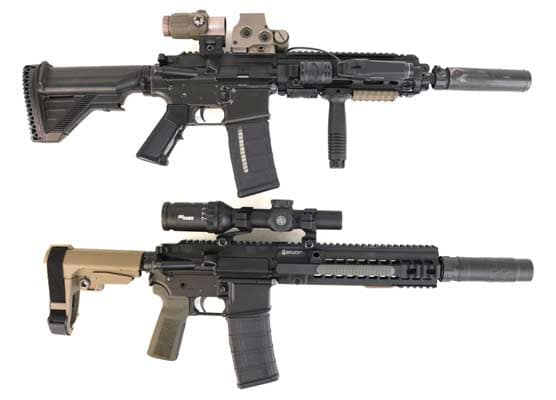Slip Fit
A Cartilaginous Lesson in Barrel Bushing Fitting

The lug is typically oversized in its width (front to rear), not height (how far it rises from the circumference of the bushing OD). Be sure to fit the correct side of the lug — start on the front when you should have filed the back, and the bushing will look like the one on the left and will not be correctly seated against the face of the slide as is the one on the right. It’s also not a bad idea to lightly dress the slide bore into which the bushing will fit and lightly bevel the rear OD of the bushing to help its insertion into the slide.

Three parts of an oversized match bushing will need to be fit: the
outside diameter (OD) where it fits the slide, the inside diameter (ID)
where it meets the barrel and the lug that holds it in the slide. Once
large enough to fit on the barrel, the ID may need to be relieved at
the rear bottom to allow the barrel to unlock.
Admittedly, it wasn’t the best idea, but it was an idea and I didn’t have any others. I was standing alone in the back room of Novak’s .45 shop fitting a 1911 with a Kart National Match barrel and bushing, the latter of which was seized fast into the slide. For those who are unfamiliar, there’s not a lot of purchase area on the lip of a barrel bushing, as it is about as thick as the silver dollars your granddad used to give you, with none of the serrated edging. It’s thin, slick and rounded, and that’s all.
Fitting a bushing to a 1911 involves fitting it to the barrel by turning down the barrel, opening up the bore of the bushing or some combination thereof and fitting the outside of the bushing to the slide by turning it in a lathe and then lapping it in. The delightfully messy lapping process consists of pasting an abrasive slurry with the thickness of mildly aged peanut butter onto a part, installing that part and then making it do whatever it does until those fine, sharp granules in the lapping compound fit the part to whatever it’s rubbing against. Lapping compound comes in grits, just like sandpaper, and also like sandpaper, it breaks down, which means taking things apart and adding more compound. It also means those parts may be stuck together when it’s time to do that, and this is the intersection at which I had arrived.

A bushing wrench is mandatory. While you shouldn’t need one to
remove the bushing when you’re done — if you do, you’re not done yet —
much of the fitting process involves rotating a bushing you will not be
able to turn with your fingers. A plastic wrench is useful for a finished pistol,
since it’s not likely to mar the pistol’s finish, but for fitting, either an aluminum
or steel wrench will last longer.

Dykem is a bright blue machinist layout fluid that dries quickly and
shows where parts are rubbing together; look for the bright spot to
know where to file. Even if the lug is still too broad to fit in its channel
in the slide, turning the bushing as far as it can go will give you a print
of where material needs to be removed. A Sharpie also works — and dries faster.

Alternately, you can use a rail micrometer to measure the distance
between the front of the slide and the rail slot, which gives you an
idea of where to start removing material from the lug, but will not
measure how narrow it should be. It should go without saying you
remove material from the bushing (the $20 part) instead of the $200
slide. Be advised good specialty measuring tools are very expensive.
You can buy a serviceable dial caliper at the auto-parts store for $40
that’s useful for all sorts of things. This Starrett rail mike is only helpful
for a couple of tasks and will cost much more than paying someone to do the job.

It’s possible, but hard, to fit a bushing entirely by hand using nothing but a file and sandpaper; that’s how Jeremy fit this King’s bushing to a Colt about 20 years ago. Use a file or sandpaper backed with a file to reduce the OD. It’s very hard to get a consistent round surface with a file, since it usually looks faceted, but shoe-shining it with the sandpaper after filing will smooth out the facets. Whichever technique you use, usually the lug and OD are fit at the same time.

The easier way to reduce the OD is to use this fixture from Brownells,
which centers the bushing on an arbor. The more worn one has been
shortened to fit the shorter Commander-size bushing. You clamp the
fixture in a ½" drill press or lathe where you can either use a file, file
and sandpaper or the lathe’s cutter to reduce the OD. If you use the
sandpaper/file technique in a lathe, cover the ways so the spent abrasive
from the sandpaper doesn’t fall on them and grind them down.
Wisdom and Muscle
A wise man will install a scrap barrel in the bushing while he fits it to the slide so it can be used as, pardon the pun, a slide hammer to drive the bushing back out the front when it inevitably gets stuck. You will note I used the phrase “a wise man will,” instead of “I did.” Having omitted this critical stage, I was back looking at that thin, slick, round lip of bushing where it stuck out the end of the slide. I carefully oriented the slide muzzle down and gently squeezed the sides of the lip in the vise. Once I had tightened the vise as tight as I felt I should, I pulled upward on the slide, which, as I had expected, was instantly released … as the vise jaws lost their grip on the bushing, which remained loftily ensconced in its new home.
Well, more force works sometimes, so I clamped it in again. Stop it with that definition of insanity; I knew what I was doing. Sensibly clamping the bushing more tightly in the vise, it immediately popped back out of the vise when I pulled on it. After several more laps of clamp-and-free, I decided to get serious and cranked the vise handle down as hard as I could, making certain it would not slip out this time. I took a robust, balanced stance, and gripped the slide firmly with both hands. I should mention at this point I had been lifting weights for about 15 years and had disproportionately strong biceps and the confidence that went with them. I manned up on it with all the strength I had.

Fitting by hand is generally a file-and-try process, but measuring will
make it much quicker. The blueprint dimension is not important: You are
fitting the bushing to whatever the slide bore actually is on your gun, not
to a theoretical best number. Any set of dial calipers will measure the bushing
OD and slide ID, but the EGW plug gauge is a fast way to measure the ID.
1911 barrels are often just a bit larger in OD at the muzzle so they’ll be tight
when locked up, but able to freely pivot downward with less friction when
cycling. If you have access to a lathe, you can cut a shallow taper to accomplish
the same thing, but if you know the correct dimensions for this you probably
don’t need this tutorial. In any event, it never hurts to make sure the surface
of the barrel is smooth prior to fitting the bushing to it, either by shoe shining
with fine sandpaper or in the lathe.

Once the bushing will go into the slide and start to turn, slather it
with lapping compound and go to town. It may require a rubber mallet
to drive the bushing in once the lapping compound is applied, and it will
be messy. Keep at it, replenishing the spent compound as you go (it breaks
down into finer particles as you work it), until the bushing can be turned by
hand throughout its entire length of travel. You’ll want to stop and clean the
compound off every so often to check the fit: If you wait until it moves that
freely when packed full of abrasive paste, you’ll likely overfit it and it will be loose.
This 600-grit lapping compound available from Brownells is significantly finer
than the valve-grinding compound you may find at your local auto-parts store.
Start with the right stuff if you want the best results. The bushing OD and lug
should be completely fit to the slide prior to fitting the ID to the barrel.

To fit the bushing ID by hand, use sandpaper wrapped around a
hard object like this oak dowel to open it up. Make sure you are removing
material consistently all around the opening; something like Dykem will
help you see where the material is coming off. There are reamers
available to do this job in the lathe.

When the bushing ID will fit over the OD of the barrel, install them in the slide and assemble the slide on the frame. Coat the barrel with lapping compound and cycle the slide — having the recoil spring in there will help push the bushing forward against the friction of the lapping compound. It’s done when the gun will lock and unlock under its own weight with the recoil spring removed. This is also where you’ll find out if there is enough relief in the bushing ID to allow the barrel to tilt and unlock. Add clearance as necessary. The bushing has a tendency to squeegee the compound off the barrel, so you may be adding a bit more. The final surface finish will be a greyish haze. Avoid the temptation to polish off, as it will loosen the fit for which you have worked so hard.
Anatomy and Physics
I feel we should talk about anatomy before we move onward and upward. A clever enough fellow can picture the skeletal structure: body slightly bent forward, forearms parallel with the floor, mightily squeezing on the slide, upper arms vertical, joining the forearms at roughly a 90-degree angle. Basic biomechanics indicates that were the forearms to be jerked upward suddenly, they would pivot, turning the 90-degree angle acute as they rotate upward until something impedes their progress. Yes, it’s basic anatomy, and you probably see it coming.
I, on the other hand, was completely surprised when the bushing slipped the surly bonds of the vise, and I promptly slammed the butt of the slide directly into my face. My nose, to be more precise. It’s hard to describe the mix of shock and pain as I staggered backward away from the vise, slide clutched in my hand, having nearly knocked myself out. It was dinner that night before someone noticed the bruising and dried blood on my face. “You look terrible,” he said. “What happened to you?”
I did finally learn how to get the bushing out: You just drive it out from the rear with a long punch. In effect, I suppose my method involved a punch as well, also the steel kind. If my nose had a slight list to one side before, I have never noticed it, so I guess I have it as souvenir. And, of course, the gun. It averaged 1.75″ at 25 yards when I finished it.
For more info: Brownells.com, EGWGuns.com








